Post by Lily on Jul 2, 2009 14:31:58 GMT -5
Last Friday, my friends Florence & Al took me out to
"Red Creek", Arizona for a hike.
They live in Cave Creek, which is north of me about an
hour drive. Northeast of Cave Creek, is an entrance to
part of the "Tonto National Forest".
This is Tonto National Forest:
www.fs.fed.us/r3/tonto/home.shtml
Even if you just look at the home page for 10 seconds, please
take a quick peek at the link. Once again, I would like
to show the diversity of Arizona's landscapes.
Tonto National Forest has just under 3 MILLION ACRES
of protected land in Arizona. It is only one of many National parks in my State.
From desert to lush pine forests and mountains just below the Mogollon Rim.
(pronounced Mo-gee-on Rim).
The elevation within Tonto ranges from 1300 feet to 7900 feet.
Boundaries are Phoenix to the south, the Mogollon Rim to the north
and the San Carlos and Fort Apache Indian reservations to the east.
Al has a 4-wheel drive truck and has, for about 40 years, been
exploring back country off road Arizona wilderness. I trust him
completely.
Al drove us 40 miles into the wilderness area off road.
We started off on a dirt road, then turned onto a "forest road"
which is basically a strip of dirt on the ground resembling a
pathway, and finally, turned onto what was in no way any type
of road at all.
We ended up at the foot of a creek, called "Red Creek". Red Creek
runs into a river called "Verde River". Our goal was to hike the
creek bed to Verde River. We didn't make it all the way to the river,
but we did do a six mile hike in the creek bed.
We then drove the 40 miles back offroad. By the end of the day it
felt like someone put a jackhammer inside my body LOL, but it was
well worth it.
Red Creek was a unique area. It is a point in elevation where the
desert floor meets the beginning of the wooded forests and mountains
of the highlands of Arizona (where it snows). Where these two
ecozones meet, cacti blend with pines, AZ Ash and cottonwood trees
join hands with desert succulents.
We saw about a million beautiful butterflies, I called them "butterflies
on speed" because none of them landed for even a moment -- therefore,
no photos of them. Some were black with blue tips, others red, orange,
and yellow.
We saw one huge Javelina (pronounced Hav-a-leena) (wild boar/pig),
coyotes, ravens, deer, elk, red ring tailed squirrels, many lizards,
catepillars, and a beautiful blue bird - not sure what kind he was.
There were swarms of yellow jackets (type of wasp) in some of the
creek pools and we steered clear of those. There were many "shiners"
(small, silver fish often used as bait by fishermen) in the creek,
they were all over the creek, huge schools of them, swimming very
quickly.
We had a picnic lunch in the truck - sadly as Lisa pointed out, no
prawn cocktail crisps! But we had ham and/or chicken sandwiches w/
cheese and green apples.
I hope you enjoy these photographs. I took over 200 but am only
posting a few. If, by some chance, you'd like to see more, I have
a photobucket link to the full album (public no p/w needed) here:
s679.photobucket.com/albums/vv159/SuzanneInez/Red%20Creek%20AZ/
I didn't have time to edit these and they lose quality transferring
from disc to photobucket, sorry.
Thanks for looking and reading, I hope you enjoy them. Would love to
hear from you if you did. Or even if you didn't enjoy them!
~~~~~~~~~~~~~~~~~~~
We passed a trailhead for The Great Western Trail.
I have hiked portions of it, and would love to hike all 800
miles of the Arizona portion.
The trail runs all the way from Canada to Mexico and is
3,000 miles long total trail.

I am sitting in back of Al's truck taking this shot.
We are at this point still in the desert.
This is what we call a "Century Plant".
Its name derives from its habit of only occasionally flowering,
but when it does, the spike with a cyme of big yellow flowers,
may reach up to 8 meters (25 ft) in height.
The plant dies after flowering, but produces suckers
or adventitious shoots from the base, which continue its growth.
The average life-span is around 28 years.

I had to have Al stop for me to hide behind a cactus at one point,
LOL, so I snapped this shot ...still in the desert at this point.
...still in the desert at this point.

This is Al's truck - which always takes me on great wilderness adventures.

We still were driving on a bit of a "road" here.

This is where we parked, at the base of Red Creek.

You will see that there is both woods and desert in this area.
It was a lovely day weather wise - much cooler than in the Phoenix
desert but not cold like up in Flagstaff area.

We even had a bit of rain at one point.
There goes Al down the creek bed (no trail or trailhead, we just
hiked down the creek). Al had a knee replacement not long ago.
He's obviously done great with it.

And there is Florence hiking along.

Green trees meet green Saguaro Cacti (pronounced Sah-war-oe).

Along the creek.

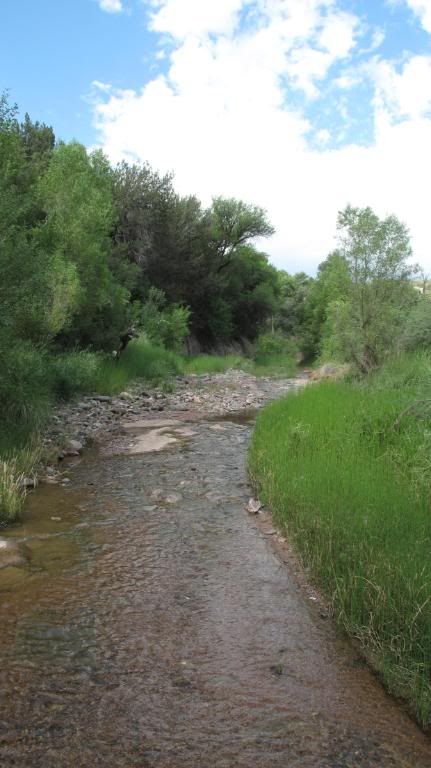
The creek runs from dry (water underground) to one inch, to several feet in places.
Arizona is rich in gemstones and minerals, much of this river bed
has iron rich mountains and rocks, which gives the rocks and mountains
their red appearance. Many of the rocks and stones we came across
were beautiful. here is an area where the water trickled more than
ran. During the rains, the creek runs full force - I will show that
later on.



Many of the trees have exposed roots.
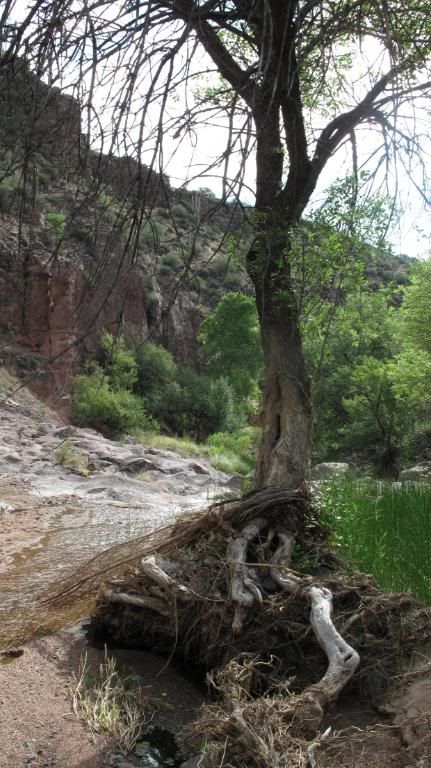
Parts of our hike were very rocky.




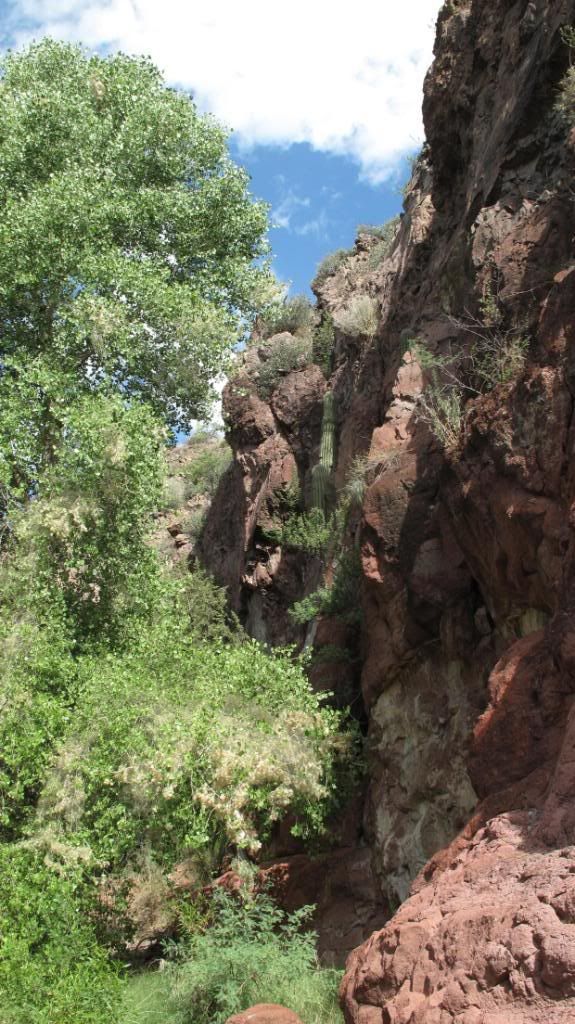
My mom likes this photo because of the rock.

This is called "Horse Hair". It is a very thick and rigid type of
grass that grows along our creek and river beds. In other photos,
you'll see that this Vertical growing grass, is bent over
horizontally along the edges of the creek - that is from the force
of the water flowing after the rains.


At certain points, the water retreated under the ground.
The creek bed is sandy and also quite rocky in places.


Al

See the roots? I will explain this later on with a different photo.
Close up of the roots.






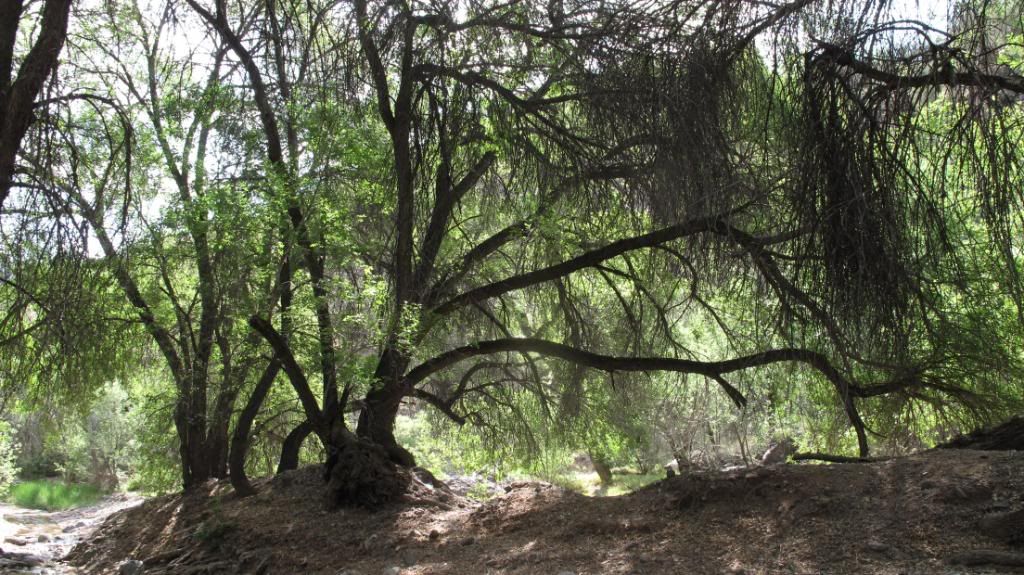
See Al on the right?
This gives depth perception to the size of the roots of the tree.
Al is my height.


LOL ... my friend said this tree looks actually scary, like he is
chasing us! And....she is right, it does look that way!

We call these "cat tails" they grow along the water.


This large boulder is full of iron which makes it red.
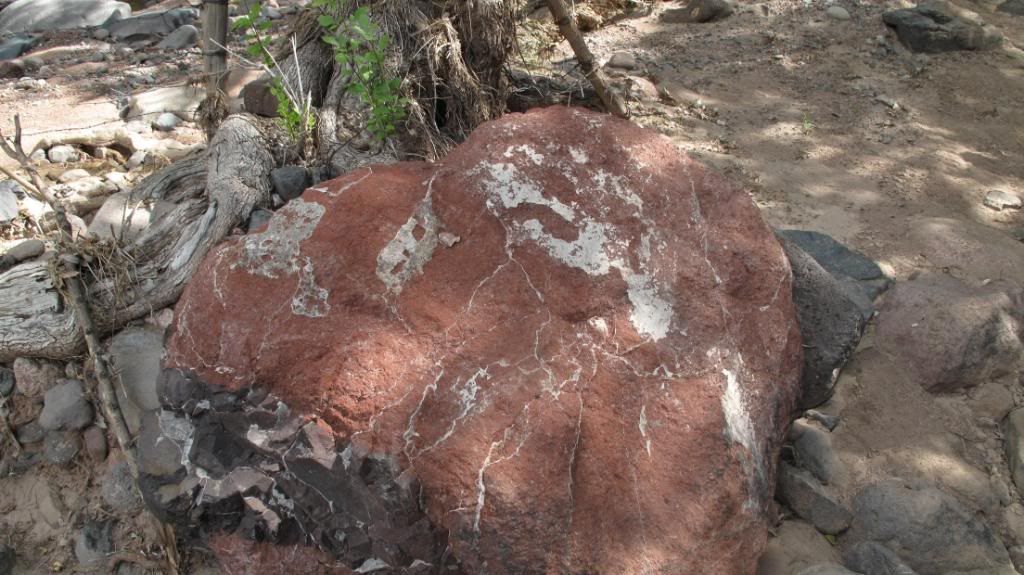
This baby Mesquite tree has managed to grow right up out of a rock surface


Al and Florence





Forest meets Cacti

You can see the rain clouds moving in here.


Okay, the exposed roots.
I will explain now.
It's because at one time those roots were submerged in water. What happens is,
it runs full of water, then dries out, then fills with water again, then dries out,
over and over during every season. Over time, from the water coming and going,
the soil erodes and leaves the roots exposed until the water covers them again.

A fairy's house at base of a tree


Trees in the area included:
Cottonwoods
Mesquites
Arizona Ash
Sycamores (similar to Birch)
Arizona Walnut
Junipers on the drive in
Others that I don't know names of!
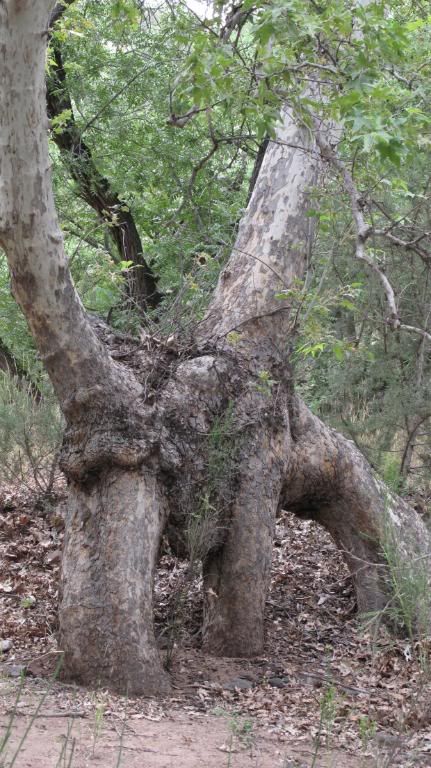

Florence helps to show size - she is by just the base of a very
large tree that has been exposed at the roots.

Al

Here is an Arizona Walnut

The pod dries out and the nut is inside it.




You can see much of this tree's roots here.

This rock is literally, chalk, that is found natural in the river beds.

Florence and Al



Here you are. See how the horse hair is forced to run horizontal
along the edges? This is because, after the rains, the creek rises
and rushes to the river in full force. It is the cause of the horse
hair flattening and browning, the erosion of the soil around the tree
roots, and the source of the smoothed natural polished stones in the
creek bed, along with the very stiff edges of the sandy creek.

Here is one of the Ravens we saw.





The white coloration on the rock here is from a waterfall with mineral
rich water. The falls are dry now, but once it rains, will be running
full again.


Here is a photo of the fish in the creek, shiners.







Almost like mini caves along the creek edges

I think I was sliding off a slippery rock when I took this,
but I sort of like it!

A lot of trees and plants had catepillar webbing on them.
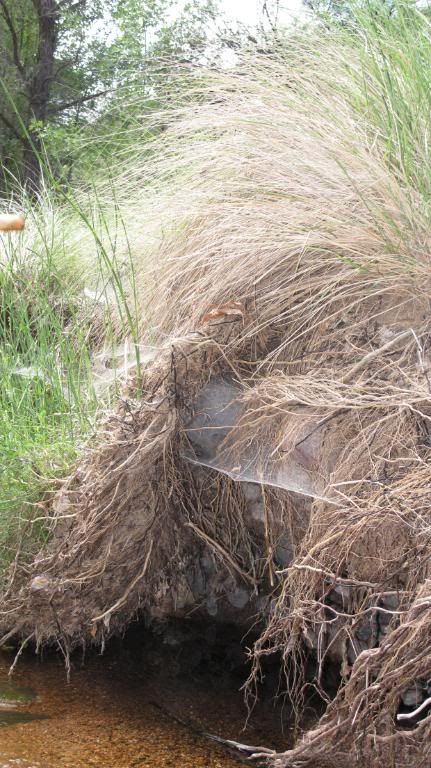
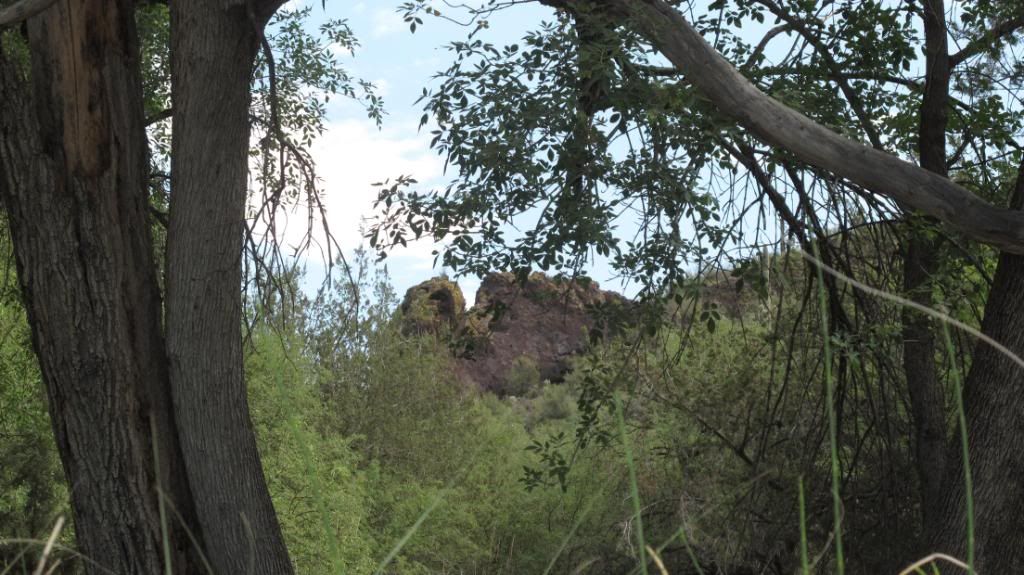
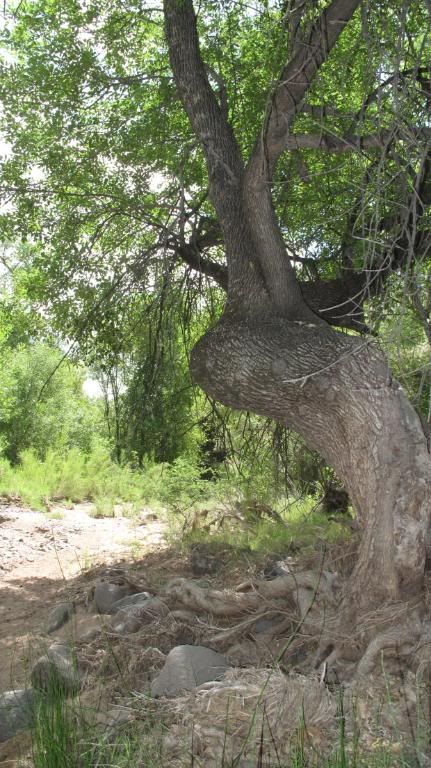
I found this rock and we are thinking it may have been a corn
grinder or something - something left over from the
Native American Indians that lived here.
It's bigger than it appears in this photo.



These

were right next to these

unique area



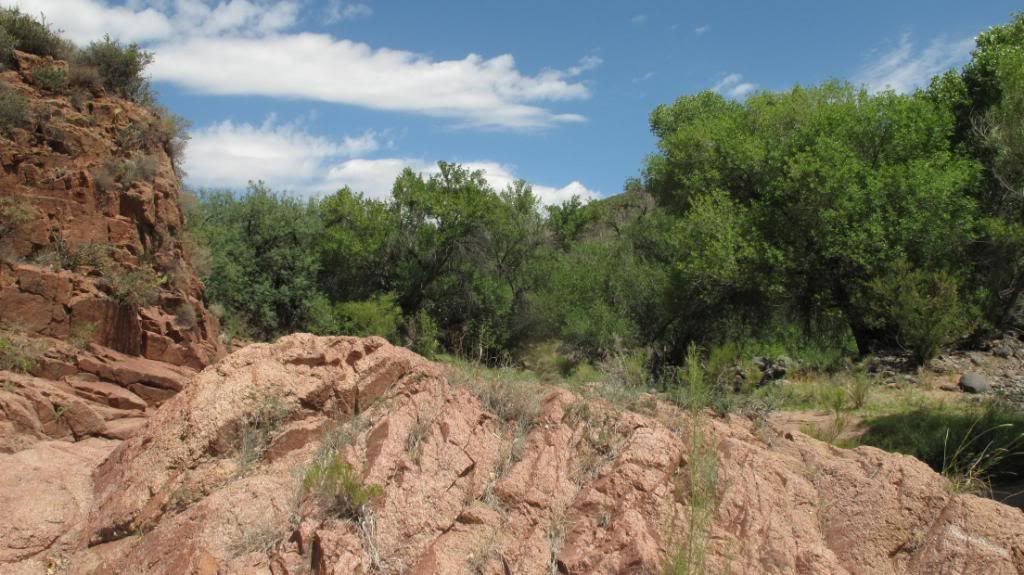






Al and Florence



A dancing lady tree:)

A catepillar


This is Catepillar webbing ... it was in a lot of the trees and plants, is the time of year.

This is a common wildflower in Arizona, it stands quite tall
sometimes, a couple feet. I don't know its name.

I hope you enjoyed hiking with me!
Thanks,
Lily
[/b][/size]
"Red Creek", Arizona for a hike.
They live in Cave Creek, which is north of me about an
hour drive. Northeast of Cave Creek, is an entrance to
part of the "Tonto National Forest".
This is Tonto National Forest:
www.fs.fed.us/r3/tonto/home.shtml
Even if you just look at the home page for 10 seconds, please
take a quick peek at the link. Once again, I would like
to show the diversity of Arizona's landscapes.
Tonto National Forest has just under 3 MILLION ACRES
of protected land in Arizona. It is only one of many National parks in my State.
From desert to lush pine forests and mountains just below the Mogollon Rim.
(pronounced Mo-gee-on Rim).
The elevation within Tonto ranges from 1300 feet to 7900 feet.
Boundaries are Phoenix to the south, the Mogollon Rim to the north
and the San Carlos and Fort Apache Indian reservations to the east.
Al has a 4-wheel drive truck and has, for about 40 years, been
exploring back country off road Arizona wilderness. I trust him
completely.
Al drove us 40 miles into the wilderness area off road.
We started off on a dirt road, then turned onto a "forest road"
which is basically a strip of dirt on the ground resembling a
pathway, and finally, turned onto what was in no way any type
of road at all.
We ended up at the foot of a creek, called "Red Creek". Red Creek
runs into a river called "Verde River". Our goal was to hike the
creek bed to Verde River. We didn't make it all the way to the river,
but we did do a six mile hike in the creek bed.
We then drove the 40 miles back offroad. By the end of the day it
felt like someone put a jackhammer inside my body LOL, but it was
well worth it.
Red Creek was a unique area. It is a point in elevation where the
desert floor meets the beginning of the wooded forests and mountains
of the highlands of Arizona (where it snows). Where these two
ecozones meet, cacti blend with pines, AZ Ash and cottonwood trees
join hands with desert succulents.
We saw about a million beautiful butterflies, I called them "butterflies
on speed" because none of them landed for even a moment -- therefore,
no photos of them. Some were black with blue tips, others red, orange,
and yellow.
We saw one huge Javelina (pronounced Hav-a-leena) (wild boar/pig),
coyotes, ravens, deer, elk, red ring tailed squirrels, many lizards,
catepillars, and a beautiful blue bird - not sure what kind he was.
There were swarms of yellow jackets (type of wasp) in some of the
creek pools and we steered clear of those. There were many "shiners"
(small, silver fish often used as bait by fishermen) in the creek,
they were all over the creek, huge schools of them, swimming very
quickly.
We had a picnic lunch in the truck - sadly as Lisa pointed out, no
prawn cocktail crisps! But we had ham and/or chicken sandwiches w/
cheese and green apples.
I hope you enjoy these photographs. I took over 200 but am only
posting a few. If, by some chance, you'd like to see more, I have
a photobucket link to the full album (public no p/w needed) here:
s679.photobucket.com/albums/vv159/SuzanneInez/Red%20Creek%20AZ/
I didn't have time to edit these and they lose quality transferring
from disc to photobucket, sorry.
Thanks for looking and reading, I hope you enjoy them. Would love to
hear from you if you did. Or even if you didn't enjoy them!
~~~~~~~~~~~~~~~~~~~
We passed a trailhead for The Great Western Trail.
I have hiked portions of it, and would love to hike all 800
miles of the Arizona portion.
The trail runs all the way from Canada to Mexico and is
3,000 miles long total trail.

I am sitting in back of Al's truck taking this shot.
We are at this point still in the desert.
This is what we call a "Century Plant".
Its name derives from its habit of only occasionally flowering,
but when it does, the spike with a cyme of big yellow flowers,
may reach up to 8 meters (25 ft) in height.
The plant dies after flowering, but produces suckers
or adventitious shoots from the base, which continue its growth.
The average life-span is around 28 years.

I had to have Al stop for me to hide behind a cactus at one point,
LOL, so I snapped this shot
 ...still in the desert at this point.
...still in the desert at this point.
This is Al's truck - which always takes me on great wilderness adventures.

We still were driving on a bit of a "road" here.

This is where we parked, at the base of Red Creek.

You will see that there is both woods and desert in this area.
It was a lovely day weather wise - much cooler than in the Phoenix
desert but not cold like up in Flagstaff area.

We even had a bit of rain at one point.
There goes Al down the creek bed (no trail or trailhead, we just
hiked down the creek). Al had a knee replacement not long ago.
He's obviously done great with it.

And there is Florence hiking along.

Green trees meet green Saguaro Cacti (pronounced Sah-war-oe).

Along the creek.


The creek runs from dry (water underground) to one inch, to several feet in places.
Arizona is rich in gemstones and minerals, much of this river bed
has iron rich mountains and rocks, which gives the rocks and mountains
their red appearance. Many of the rocks and stones we came across
were beautiful. here is an area where the water trickled more than
ran. During the rains, the creek runs full force - I will show that
later on.



Many of the trees have exposed roots.

Parts of our hike were very rocky.





My mom likes this photo because of the rock.

This is called "Horse Hair". It is a very thick and rigid type of
grass that grows along our creek and river beds. In other photos,
you'll see that this Vertical growing grass, is bent over
horizontally along the edges of the creek - that is from the force
of the water flowing after the rains.


At certain points, the water retreated under the ground.
The creek bed is sandy and also quite rocky in places.


Al

See the roots? I will explain this later on with a different photo.

Close up of the roots.







See Al on the right?
This gives depth perception to the size of the roots of the tree.
Al is my height.


LOL ... my friend said this tree looks actually scary, like he is
chasing us! And....she is right, it does look that way!


We call these "cat tails" they grow along the water.


This large boulder is full of iron which makes it red.

This baby Mesquite tree has managed to grow right up out of a rock surface


Al and Florence





Forest meets Cacti

You can see the rain clouds moving in here.


Okay, the exposed roots.
I will explain now.
It's because at one time those roots were submerged in water. What happens is,
it runs full of water, then dries out, then fills with water again, then dries out,
over and over during every season. Over time, from the water coming and going,
the soil erodes and leaves the roots exposed until the water covers them again.

A fairy's house at base of a tree


Trees in the area included:
Cottonwoods
Mesquites
Arizona Ash
Sycamores (similar to Birch)
Arizona Walnut
Junipers on the drive in
Others that I don't know names of!


Florence helps to show size - she is by just the base of a very
large tree that has been exposed at the roots.

Al

Here is an Arizona Walnut

The pod dries out and the nut is inside it.




You can see much of this tree's roots here.

This rock is literally, chalk, that is found natural in the river beds.

Florence and Al



Here you are. See how the horse hair is forced to run horizontal
along the edges? This is because, after the rains, the creek rises
and rushes to the river in full force. It is the cause of the horse
hair flattening and browning, the erosion of the soil around the tree
roots, and the source of the smoothed natural polished stones in the
creek bed, along with the very stiff edges of the sandy creek.

Here is one of the Ravens we saw.





The white coloration on the rock here is from a waterfall with mineral
rich water. The falls are dry now, but once it rains, will be running
full again.


Here is a photo of the fish in the creek, shiners.







Almost like mini caves along the creek edges

I think I was sliding off a slippery rock when I took this,
but I sort of like it!


A lot of trees and plants had catepillar webbing on them.



I found this rock and we are thinking it may have been a corn
grinder or something - something left over from the
Native American Indians that lived here.
It's bigger than it appears in this photo.



These

were right next to these

unique area










Al and Florence



A dancing lady tree:)

A catepillar


This is Catepillar webbing ... it was in a lot of the trees and plants, is the time of year.

This is a common wildflower in Arizona, it stands quite tall
sometimes, a couple feet. I don't know its name.

I hope you enjoyed hiking with me!
Thanks,
Lily

[/b][/size]














